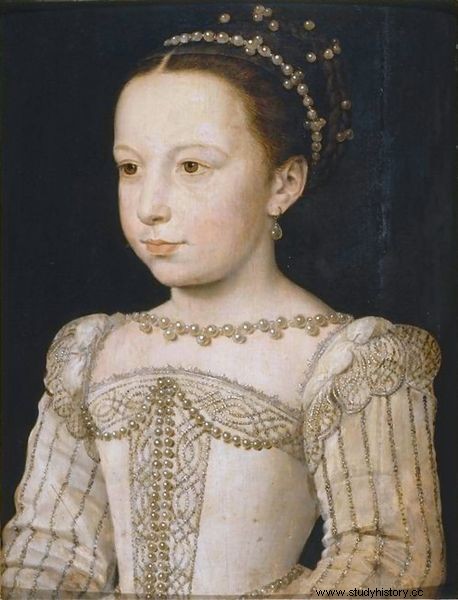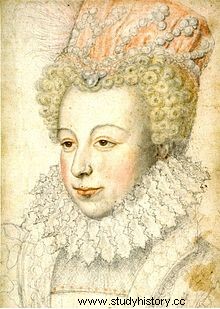Marguerite of France or Marguerite de Valois (1553-1615) was a French princess who became Queen of Navarre and Queen of France. Intelligent and cultured, she played an important role in the cultural life of the court.
Marriage negotiations
 Born May 14, 1553, Marguerite de France was the seventh child of Henry II and Catherine de Medici. Injured during a tournament, her father died when she was six years old and her relationship with her mother, queen regent, was distant. Her sisters quickly left to marry abroad and Marguerite grew up with her brothers, with whom she maintained excellent relations, at court.
Born May 14, 1553, Marguerite de France was the seventh child of Henry II and Catherine de Medici. Injured during a tournament, her father died when she was six years old and her relationship with her mother, queen regent, was distant. Her sisters quickly left to marry abroad and Marguerite grew up with her brothers, with whom she maintained excellent relations, at court.
At the end of the 1560s, an idyll was born between Marguerite and Henri de Lorraine, Duke of Guise. A radical Catholic, the latter advocates extreme measures against Protestantism, which goes against the policy desired by the Valois. In addition, matrimonial negotiations are then in progress. The affair was very badly received by the royal family and created a lasting cold between Marguerite and her mother as well as between Marguerite and her brother Henri, the future Henri III.
Catherine de Medici engages in negotiations with Henri de Navarre (future Henri IV), young leader of the Protestant party, for the hand of Marguerite. Jeanne d'Albret, mother of Henri de Navarre, first demanded that the princess convert to Protestantism, but the latter refused and this demand was abandoned. On August 18, 1572, Marguerite married, not without reluctance, Henri de Navarre.
Red Weddings
In a context of religious war, the marriage concretized peace between Catholics and Protestants, but this truce was short-lived:on the night of August 23 to 24, 1572, the Massacre of Saint-Barthélemy began, during which thousands of Protestants are murdered. The weddings are then nicknamed the “vermilion weddings” and Marguerite is held in suspicion both by her husband and by the king, her brother.
 In 1574, King Charles IX was dying and a Protestant revolt, including Henry of Navarre, put in carried out several plots to seize power. Out of loyalty to her brothers, Marguerite denounces the plot at first but ends up joining the Malcontents to regain her husband's confidence. But the plot is foiled, one of the leaders is executed and Henri de Navarre imprisoned. Marguerite writes a pleading to defend her husband and, when her brother Henri III comes to power, the conspirators are left on probation at court. The king, however, will not forgive his sister.
In 1574, King Charles IX was dying and a Protestant revolt, including Henry of Navarre, put in carried out several plots to seize power. Out of loyalty to her brothers, Marguerite denounces the plot at first but ends up joining the Malcontents to regain her husband's confidence. But the plot is foiled, one of the leaders is executed and Henri de Navarre imprisoned. Marguerite writes a pleading to defend her husband and, when her brother Henri III comes to power, the conspirators are left on probation at court. The king, however, will not forgive his sister.
Relations between Henri and Marguerite deteriorate, particularly because the couple has no heirs. The two have various relationships. In 1576, Henri de Navarre fled – without telling his wife – and Marguerite, held to be an accomplice, was imprisoned in the Louvre. She was eventually released during peace negotiations. In 1577, the war resumed and Marguerite went on a diplomatic mission to the Netherlands on behalf of her younger brother before returning to court. She then obtained permission to join her husband in his kingdom of Navarre.
House arrest at the Château d’Ibois
The couple settled in Nérac, capital of Albret, where Marguerite worked to create a refined court life, gathering around her poets and writers including Agrippa d'Aubigné and Montaigne. But her situation deteriorates:one of her bridesmaids becomes pregnant by her husband, while the couple still has no children. In 1582, Marguerite returned to Paris, probably under pressure from her mother and her brother the king. However, back at court, she made fun of her brother's morals and led a dissolute life, and in 1583 Henry III drove her sister out of court. Marguerite reunites with her husband eight months later.
The war resumed in 1585 and, rejected by her family and her husband, Marguerite joined the party of intransigent Catholics and opponents of the king. Countess of Agen, she reinforces the walls and raises troops to attack the surrounding cities but her troops revolt and Marguerite has to flee. Besieged at the Château d'Ibois, in Auvergne, she found herself under house arrest when the royal troops seized the fortress. She manages to soften her detention by buying off her guardian, but suffers from isolation and undertakes to write her memoirs to pass the time.
Queen Margot
In 1589, Catherine de Médicis then Henri III died and Henri de Navarre inherited the throne of France. Marguerite then begins negotiations with her husband who wishes to have their marriage annulled on the grounds of sterility and to remarry. Marguerite supports his request in exchange for financial compensation and the fact that she can keep her title, and in 1599 the pope annuls the marriage. In 1605, Marguerite finally returned to Paris.
Opposite the Louvre, she had a hotel built which was soon to become the new meeting place for writers and artists. She gave many receptions there and surrounded herself with poets and philosophers; his hotel became an important place in the cultural, intellectual and political life of Parisian life.
Marguerite de France died in 1615. The target of violent pamphlets during her lifetime, the calumnies widespread in her time veiled her story and created the myth of the nymphomaniac and incestuous “Queen Margot”. Historians have rehabilitated it since the 19th century.
